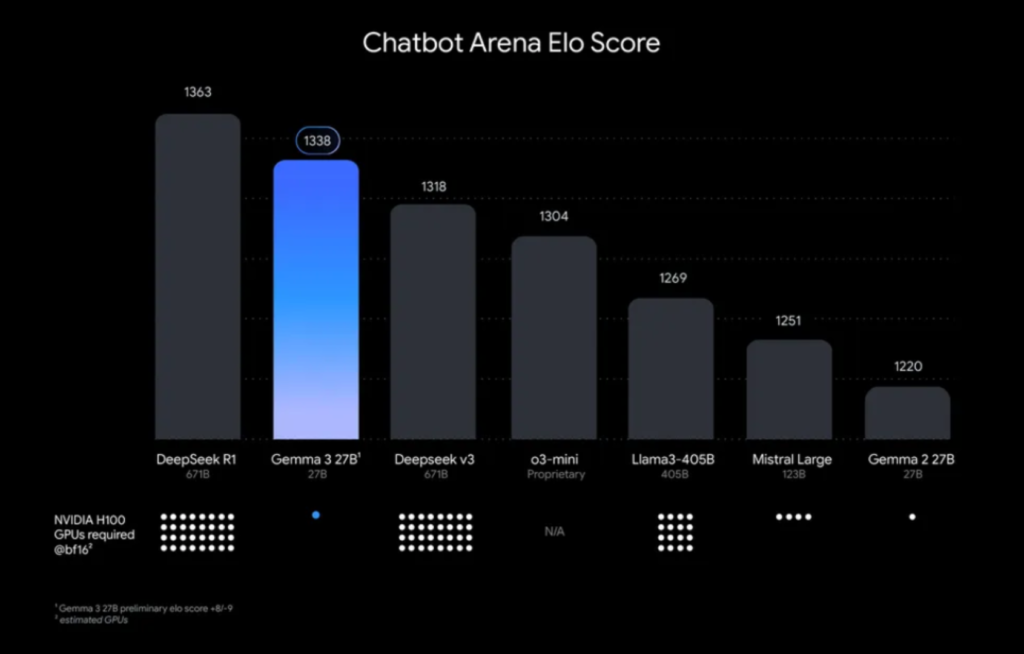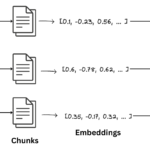Artificial Intelligence (AI) is evolving fast, and Google is leading the charge with Gemma 3, their newest lightweight AI model released . Built on the same tech as Google’s powerful Gemini 2.0, Gemma 3 is designed to be fast, efficient, and accessible—running on everything from laptops to phones with just a single GPU or TPU. Whether you’re a developer, a small business owner, or an AI enthusiast, this blog will give you a full rundown of what Gemma 3 is, why it matters, and how it can power your next big idea. Let’s dive into this game-changing model!
1. What is Gemma 3?
Gemma 3 is Google’s latest leap in the world of open-source AI, unveiled just days ago . It’s the third iteration in the Gemma family, succeeding Gemma 1 and Gemma 2 . Unlike its beefier cousin, Gemini 2.0, Gemma 3 is a “lightweight” powerhouse engineered for efficiency—delivering high-end performance without the need for sprawling server farms. Available in four distinct sizes, it caters to a wide range of users:
- 1B (1 billion parameters): A compact, text-only model perfect for lightweight tasks like drafting emails, generating summaries, or powering simple chatbots.
- 4B (4 billion parameters): Steps up with image processing, ideal for apps that need to interpret visuals alongside text.
- 12B (12 billion parameters): A mid-tier powerhouse for larger projects, such as analyzing datasets or building advanced conversational agents.
- 27B (27 billion parameters): The flagship version, excelling at complex, multimodal tasks like video analysis or multi-step reasoning.
What sets Gemma 3 apart? It’s optimized to run on a single accelerator—think an Nvidia RTX 4090 GPU or Google’s TPU v5e—earning it the title of “the world’s best single-accelerator model” from Google. Better yet, it’s free to download and fully customizable, making it a dream come true for developers, startups, and hobbyists who don’t have access to cloud-scale budgets. Imagine running a cutting-edge AI on your personal laptop—that’s the Gemma 3 promise.
2. Key Features of Gemma 3 That Make It Stand Out
Gemma 3 isn’t just another model in the crowded AI landscape—it’s a feature-packed marvel that punches well above its weight. Here’s what makes it shine:
- Multimodal Capabilities:
- The 4B, 12B, and 27B versions can process text, images, and even short video clips (up to 30 seconds in the 27B model).
- Example: Upload a photo of a dish and ask, “What’s the recipe?” or feed it a video of a lecture and get a concise summary.
- The 1B model sticks to text but still delivers impressive results for its size.
- Massive Context Window:
- Boasts a 128,000-token context window (32,000 for the 1B version)—enough to process entire novels, lengthy legal documents, or hours-long chat histories in one go.
- Compared to competitors like Llama-405B (128K tokens) or GPT-4o (128K), it’s on par, but its single-device efficiency sets it apart.
- Multilingual Power:
- Natively supports over 35 languages, including English, Spanish, Mandarin, and Arabic, with pretraining extending its reach to 140+ languages.
- Excels at translation, cross-lingual summarization, and even code-switching in multilingual conversations.
- Unmatched Performance:
- Google claims Gemma 3 outperforms giants like Meta’s Llama-405B (405 billion parameters), OpenAI’s o3-mini, and DeepSeek’s V3 in LMArena’s blind user tests.
- The 27B version boasts a 1338 Elo score in chatbot rankings, placing it among the elite while requiring a fraction of the resources.
- Lightweight Efficiency:
- The 1B model weighs in at just 900MB and churns out 2585 tokens per second on a mid-range device like an M2 MacBook Air.
- Even the 27B version fits on a single high-end GPU, slashing energy costs and carbon footprints compared to cloud-reliant models.
- Function Calling & Structured Output:
- Developers can hook it up to external APIs or tools, enabling tasks like fetching live data, generating JSON responses, or automating workflows.
- Example: Ask it to “schedule a meeting” by integrating with Google Calendar—it’s like giving your AI assistant a toolbox.
- Open-Source Flexibility:
- Released under a permissive license, you can tweak its weights, fine-tune it with custom datasets, or even strip it down for specific use cases—all for free.
3. How Does Gemma 3 Work? The Tech Made Simple
Gemma 3 might sound like magic, but it’s a carefully engineered blend of cutting-edge tech and practical design. Here’s a breakdown for non-experts:
- Training:
- Built on a colossal 14-trillion-token dataset—think billions of web pages, books, images, and code snippets—processed using Google’s custom TPU v5e chips.
- This diversity gives it a broad “worldview,” from scientific papers to casual social media posts.
- Multimodal Design:
- The 4B+ versions leverage SigLIP (a vision-language system) to interpret images and videos alongside text.
- Example: It can “read” a chart and explain its trends or describe a scene from a video frame-by-frame.
- Smart Attention Mechanism:
- Combines local sliding window attention (for fine details) with global attention (for overarching context), making it adept at both short queries and sprawling documents.
- Tokenizer Upgrade:
- Inherits Gemini 2.0’s advanced tokenizer, improving efficiency for non-Latin scripts like Chinese, Korean, and Devanagari—up to 20% better compression than Gemma 2.
- Architecture:
- Transformer-based with Rotary Positional Embeddings (RoPE), a technique that helps it track relationships in long sequences without losing accuracy.
The result? A fast, flexible AI that doesn’t demand a supercomputer.
4. Gemma 3 vs. Gemma 2: What’s New?
Gemma 3 builds on its predecessor with significant upgrades. Here’s how it stacks up:
- Context Window:
- Gemma 3: 128,000 tokens (32,000 for 1B) vs. Gemma 2: 8,000 tokens—a 16x jump in capacity.
- Practical impact: Analyze a 500-page book in one pass instead of chunking it.
- Multimodal Support:
- Gemma 2 was text-only; Gemma 3 (4B+) adds image and video processing.
- Example: Gemma 2 could summarize a report; Gemma 3 can also describe its cover image.
- Performance Boost:
- The 27B version outperforms Gemma 2’s 27B by 15% on benchmarks like MMLU (general knowledge) and GSM8K (math reasoning).
- It’s also 10% faster in inference thanks to optimized quantization.
- Efficiency Gains:
- File sizes are smaller (1B at 900MB vs. 1.3GB for Gemma 2’s smallest model) while delivering more power per parameter.
- New Features:
- Function calling and structured outputs make Gemma 3 a developer’s best friend—features absent in Gemma 2.
It’s a clear upgrade, making Gemma 3 more powerful and versatile.
5. Real-World Uses for Gemma 3
Gemma 3’s versatility opens up a world of possibilities. Here are some expanded use cases with examples:
- Build a Chatbot:
- Craft a multilingual customer support bot that runs offline on a Raspberry Pi—perfect for small businesses or remote areas.
- Example: A travel agency bot that answers queries in 10 languages and pulls flight data via API.
- Analyze Media:
- Develop an app that captions photos for the visually impaired or summarizes YouTube tutorials in seconds.
- Example: Upload a cooking video and get a step-by-step recipe list.
- Write Content:
- Generate SEO-friendly blog posts, short stories, or ad copy with a human-like tone.
- Example: “Write a 500-word article on sustainable fashion” yields polished results in under a minute.
- Code Helper:
- Debug Python scripts, generate SQL queries, or build full apps with its function-calling prowess.
- Example: “Fix this buggy loop” or “Write a Flask API for a to-do list.”
- Education Tool:
- Summarize dense textbooks, explain quantum physics in plain English, or quiz students interactively.
- Example: A teacher uses the 12B model to create custom lesson plans from uploaded PDFs.
- Business Automation:
- Automate email responses, extract insights from sales reports, or schedule team tasks.
- Example: A startup uses the 4B model to categorize customer feedback without cloud costs.
- Creative Projects:
- Design a game NPC that reacts to player dialogue or compose poetry in multiple styles.
- Example: “Write a haiku about spring in Japanese and English.”
Since it’s open-source, you can tweak it for niche needs—like a medical chatbot or a local language translator.
6. How to Get Started with Gemma 3
Diving into Gemma 3 is easier than you think. Here’s your step-by-step guide:
- Test Online:
- Head to Google AI Studio (ai.google.com/studio) for a no-install playground—experiment with all sizes instantly.
- Download:
- Available on Hugging Face, Kaggle, or Ollama.
- Example command:
ollama pull gemma3:4bgrabs the 4B version in minutes.
- Run Locally:
- Use Hugging Face Transformers (Python-based) or Ollama for a simple setup.
- Requirements:
- 1B: Runs on a phone or low-end PC (4GB RAM).
- 27B: Needs a beefy GPU (e.g., Nvidia H100 with 24GB VRAM).
- Customize:
- Fine-tune it on Google Colab (free tier for 1B) or Vertex AI for pro-level tweaking.
- Example: Train it on your company’s manuals for a bespoke assistant.
- No Hardware?
- The 1B model runs on almost anything—even a 5-year-old laptop—making it ultra-accessible.
No GPU? No worries—the 1B version runs on almost anything!
7. Gemma 3 vs. the Competition
How does Gemma 3 fare against its rivals? Let’s break it down:

- Meta’s Llama-405B:
- Gemma 3’s 27B beats it in LMArena’s chatbot rankings (1338 vs. 1305 Elo) with 15x fewer parameters—efficiency wins.
- OpenAI’s o3-mini:
- Gemma 3 edges ahead in human preference tests (52% vs. 48%) and runs locally, unlike o3-mini’s cloud reliance.
- DeepSeek-V3:
- Gemma 3 excels in multilingual tasks (35+ native languages vs. DeepSeek’s 20) and single-device performance.
- Gemini 1.5 Pro:
- Google’s own heavyweight outclasses Gemma 3 in raw power (e.g., complex reasoning), but Gemma 3 wins on portability and cost.

For creative writing, it’s a star; for tricky logic puzzles, it’s good but not the best.
8. Why Gemma 3 Matters for the Future
Gemma 3 isn’t just an AI model—it’s a movement. By making advanced AI portable, efficient, and free, Google is democratizing technology. Small startups, students, and hobbyists can now compete with big players without million-dollar budgets. Plus, its offline capability means AI can reach remote areas without internet access—a game-changer for education and healthcare.
9. Final Thoughts: Should You Use Gemma 3?
Gemma 3 is a game-changer for anyone who wants powerful AI without the complexity or cost. Developers can build groundbreaking apps, businesses can streamline operations, and creators can unleash their imagination—all on a budget. Its blend of performance, portability, and openness makes it a must-try.


